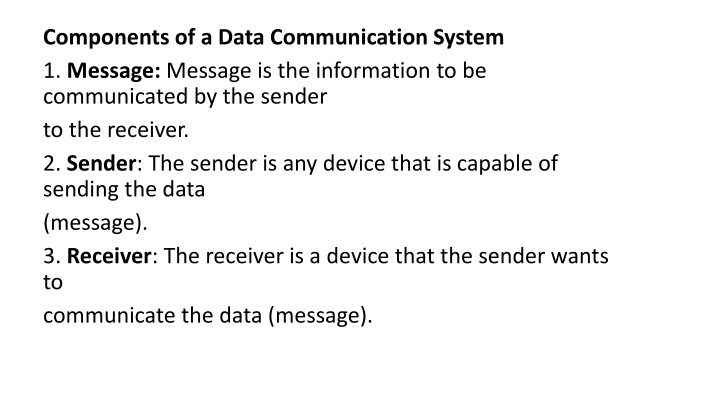
Components of Data Communication Systems
Explore the key components of a data communication system, including messages, senders, receivers, transmission mediums, protocols, and data representation formats like text, numbers, images, audio, and video.
Download Presentation

Please find below an Image/Link to download the presentation.
The content on the website is provided AS IS for your information and personal use only. It may not be sold, licensed, or shared on other websites without obtaining consent from the author. If you encounter any issues during the download, it is possible that the publisher has removed the file from their server.
You are allowed to download the files provided on this website for personal or commercial use, subject to the condition that they are used lawfully. All files are the property of their respective owners.
The content on the website is provided AS IS for your information and personal use only. It may not be sold, licensed, or shared on other websites without obtaining consent from the author.
E N D
Presentation Transcript
Components of a Data Communication System 1. Message: Message is the information to be communicated by the sender to the receiver. 2. Sender: The sender is any device that is capable of sending the data (message). 3. Receiver: The receiver is a device that the sender wants to communicate the data (message).
4. Transmission Medium: It is the path by which the message travels from sender to receiver. It can be wired or wireless and many subtypes in both. 5. Protocol: It is an agreed upon set or rules used by the sender and receiver to communicate data. A protocol is a set of rules that governs data communication. A Protocol is a necessity in data communications without which the communicating entities are like two persons trying to talk to each other in a different language without know the other language.
1.4 DATA REPRESENTATION 1.4 DATA REPRESENTATION Data is collection of raw facts which is processed to deduce information. There may be different forms in which data may be represented. Some of the forms of data used in communications are as follows: 1. Text: Text includes combination of alphabets in small case as well as upper case. It is stored as a pattern of bits. Prevalent encoding system : ASCII, Unicode
2. Numbers: Numbers include combination of digits from 0 to 9. It is stored as a pattern of bits. Prevalent encoding system : ASCII, Unicode 3. Images An image is worth a thousand words is a very famous saying. In computers images are digitally stored. A Pixel is the smallest element of an image. To put it in simple terms, a picture or image is a matrix of pixel elements. The pixels are represented in the form of bits. Depending upon the type of image (black n white or color) each pixel would require
different number of bits to represent the value of a pixel. The size of an image depends upon the number of pixels (also called resolution) and the bit pattern used to indicate the value of each pixel. Example: if an image is purely black and white (two color) each pixel can be represented by a value either 0 or 1, so an image made up of 10 x 10 pixel elements would require only 100 bits in memory to be stored. On the other hand an image that includes gray may require 2 bits to represent every pixel value (00 - black, 01 dark gray, 10 light gray, 11 white). So the same 10 x 10 pixel image would now require 200 bits of memory to be stored. Commonly used Image formats : jpg, png, bmp, etc
4. Audio: Data can also be in the form of sound which can be recorded and broadcasted. Example: What we hear on the radio is a source of data or information. Audio data is continuous, not discrete. 5. Video: Video refers to broadcasting of data in form of picture or movie
1.5 DATA FLOW 1.5 DATA FLOW Two devices communicate with each other by sending and receiving data. The data can flow between the two devices in the following ways. 1. Simplex 2. Half Duplex 3. Full Duplex
In Simplex, communication is unidirectional Only one of the devices sends the data and the other one only receives the data. Example: in the above diagram: a cpu send data while a monitor only receives data. 1.5.2 Half Duplex In half duplex both the stations can transmit as well as receive but not at the same time. When one device is sending other can only receive and vice-versa (as shown in figure above.) Example: A walkie-talkie.
1.5.3 Full Duplex In Full duplex mode, both stations can transmit and receive at the same time. Example: mobile phones















